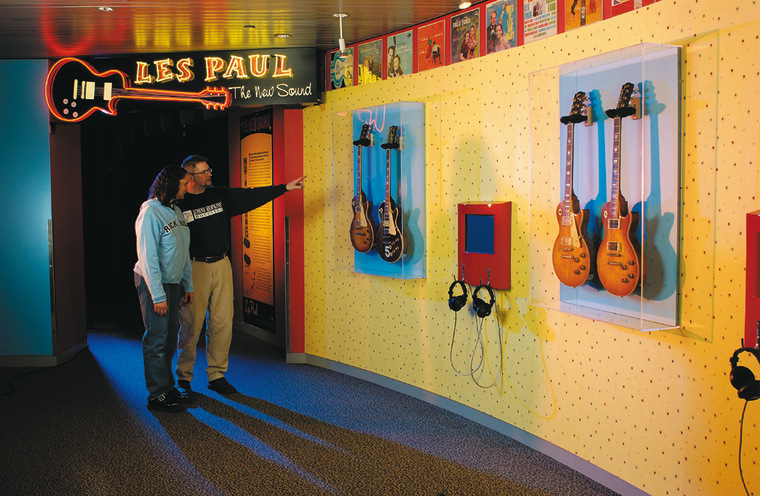To a Shakespeare buff, it’s the Globe Theatre. To a mountaineer, it's Everest. A tennis fan, Wimbledon. These are the places that need no introduction, where history merges with legend and the luster lasts for decades—or centuries.
American music has its iconic places, too. The Big Apple’s Cotton Club, the Big Easy’s French Quarter, the Windy City’s blues joints, Nashville’s Grand Ole Opry—these are the crucibles where talents, trends and inspiration combined and collided. The spots where genius rubbed up against opportunity, where rhythms imported from one continent gave life to harmonies borrowed from another. They are the places where Satchmo blew his golden trumpet, where Diz, Bird and their high-flying friends invented bebop, where Miles defined cool, where Dylan spun his immortal lines and rhymes.
Our iconic music cities are part of our history, but that doesn’t mean that music is confined to the past. Quite the contrary. Sure, we can visit the museum exhibits, take the tours, see the old studios and stock up on scratchy LPs and memorabilia. But we can also tap our feet to the here-and-now, listening to an after-hours jam session in a New Orleans bar, a roof-raising gospel chorus in a Harlem church, the driving punk rhythms in a Seattle club, or the new country tunes spilling out at a Nashville open-mike. In the same cities where jazz was invented, where grunge exploded, where the blues electrified and where country twanged, we can still hear music history being made.
Where to start? A comprehensive tour of America’s iconic music cities takes you clear across the country, up and down each coast. But you don’t have to visit them all at once. Travel to any one of these regions, and you’ve got treats in store.
The South
Pride of place has to go to New Orleans, birthplace of jazz. The tail of a comet doesn’t burn any brighter than the century-long trail of genius imprinted on the Crescent City’s musical life. Louis Armstrong trumpeted his first notes here, Jelly Roll Morton tickled the ivories and Sidney Bechet blew his clarinet, to name just three legends. But New Orleans’ music genius extends to current names as well: the Marsalis brothers, Dr. John, the Neville Brothers and Harry Connick, Jr., all hail from the Big Easy, their names and careers as bright as those of their forebears.
Citifed New Orleans jazz had a country cousin in the Delta blues. The so-called Blues Highway runs up the Mississippi Delta to Memphis, passing historic blues haunts like Jackson, Miss. If the Blues highway is a pilgrim’s path, its holy grail is a place known simply as the Crossroads, the junction of Highways 61 and 49 in Clarksdale, where, as any blues fan can tell you, the blues giant Robert Johnson sold his soul to the devil in exchange for his talent. Further north, you arrive in Memphis, capital of the Mississippi Delta, birthplace of Aretha Franklin and the home of soul. It’s also the place where country music and southern blues came together in the person of the one and only Elvis. Today’s Memphis is a gritty city, but Graceland is an American icon, and the city’s Stax Museum of American Soul honors the artists who gave the world its sound.
The sounds are very different in Nashville, where steel guitars sweep and glide over tunes of lost love and hard times, this time twanging with a country accent. This is a city that revels in both its musical past and present. You can take in a show at the Grand Ole Opry—the world’s longest-running country radio show—but don’t miss the open mikes where tomorrow’s talents are paying their dues.
The Midwest
From southern towns and fields, jazz and blues followed the great black migration to northern cities. But the path wasn’t a straight line. Musicians wandered in a maze of seemingly random rabbit trails, trying their luck here and there, often brushing up against one another. Sometimes they collided, sometimes they collaborated, but they always created. In Kansas City, St. Louis, Detroit and Chicago, the creativity leapt to a whole new level
Along Kansas’s City’s 18th and Vine, you could hear Count Basie. In Detroit, the Motown sound emerged and took over the nation’s airwaves. In Chicago, Chess Records recorded everyone from Muddy Waters to the Rolling Stones, and the blues plugged in and took on a whole new driving urban energy.
The West

Tired of history? Go west, young man, to San Francisco and Seattle, where music is a young person’s story—intermingled with politics and ideals and exploration and, yes, sex and drugs and rock 'n' roll. Music wasn’t so much a process as an explosion: a rebellion, a social comment, a celebration of life, all wrapped into an exuberant sound package, with amps turned up to 11. Today, you can relive those heady days on tours of Haight-Ashbury or in the punk clubs of the Emerald City.
The Northeast
If we started with New Orleans, we have to wrap up with New York, the ultimate melting pot, collision zone, cultural mosaic—take your pick. From the West Village clubs where Dylan mesmerized his audiences, to the midtown jazz joints of 52nd Street, to the formal niceties of Lincoln Center, to Harlem’s Saturday night burlesque clubs and Sunday morning church services—The Big Apple has everything.
Take just one example. An Eastern European man arrives in 1892 to accept the position of director of New York’s National Conservatory of Music. He travels to America’s rural south and hears African-American spiritual songs, Indian motifs and American folk themes—and eventually writes a symphony that incorporates all he's heard. Antonin Dvorak's “New World Symphony” is still debated musicologists, but it's undoubtedly beloved. It's New World meets Old. Symphonic form meets popular song.
It's also the quintessential American music story—a collision of tradition and talent, a melange of classic and modern. And there are thousands of similar stories to be found in our iconic music cities.
